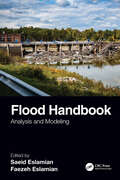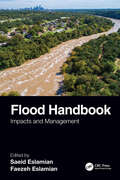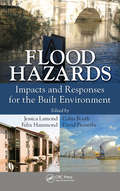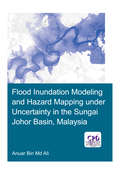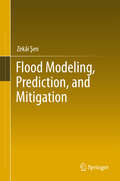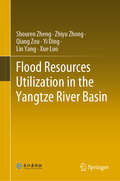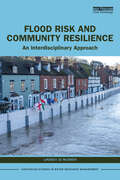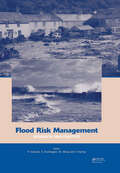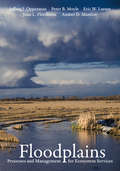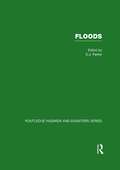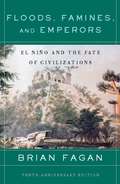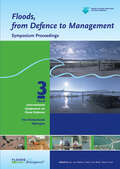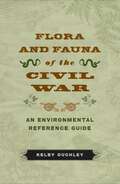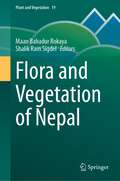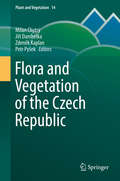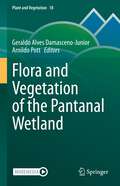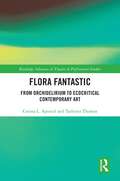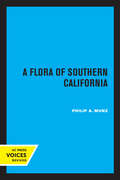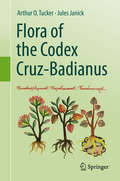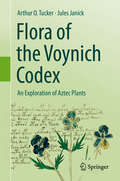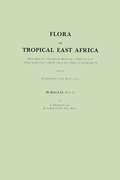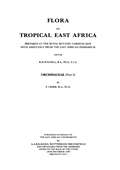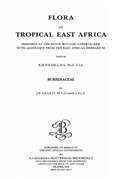- Table View
- List View
Flood Handbook: Analysis and Modeling
by Saeid Eslamian and Faezeh EslamianFloods are difficult to prevent but can be managed in order to reduce their environmental, social, cultural, and economic impacts. Flooding poses a serious threat to life and property, and therefore it’s very important that flood risks be taken into account during any planning process. This handbook presents different aspects of flooding in the context of a changing climate and across various geographical locations. Written by experts from around the world, it examines flooding in various climates and landscapes, taking into account environmental, ecological, hydrological, and geomorphic factors, and considers urban, agricultural, rangeland, forest, coastal, and desert areas. Features: Presents the main principles and applications of the science of floods, including engineering and technology, natural science, and sociological implications. Considers floods in urban, agricultural, rangeland, forest, coastal, and desert areas. Covers flood control structures as well as preparedness and response methods. Written in a global context, by contributors from around the world.
Flood Handbook: Impacts and Management
by Saeid Eslamian and Faezeh EslamianFloods are difficult to prevent but can be managed in order to reduce their environmental, social, cultural, and economic impacts. Flooding poses a serious threat to life and property, and therefore it’s very important that flood risks be taken into account during any planning process. This handbook presents different aspects of flooding in the context of a changing climate and across various geographical locations. Written by experts from around the world, it examines flooding in various climates and landscapes, taking into account environmental, ecological, hydrological, and geomorphic factors, and considers urban, agriculture, rangeland, forest, coastal, and desert areas. Features Presents the main principles and applications of the science of floods, including engineering and technology, natural science, as well as sociological implications. Examines flooding in various climates and diverse landscapes, taking into account environmental, ecological, hydrological, and geomorphic factors. Considers floods in urban, agriculture, rangeland, forest, coastal, and desert areas Covers flood control structures as well as preparedness and response methods. Written in a global context, by contributors from around the world.
Flood Hazards: Impacts and Responses for the Built Environment
by Jessica Lamond David Proverbs Colin Booth Felix HammondA 360-degree view of the response to flood riskAs major flooding events around the world show, the impact of flooding on the built environment can cause widespread chaos. These flood events form part of a wider pattern of increasing flood frequency coupled with increased vulnerability of the built environment to flood hazard. Flood risk can unite o
Flood Inundation Modeling and Hazard Mapping under Uncertainty in the Sungai Johor Basin, Malaysia (IHE Delft PhD Thesis Series)
by Anuar Bin AliFlooding can have devastating impacts on people’s livelihood, economy and the environment. An important instrument in flood management is floodplain maps, which assist land planners and local authorities in identifying flood-prone areas, and provide useful information for rescue and relief agencies for their operations. Developing floodplain maps often involves flood inundation modeling. This typically requires precipitation and stream flow data, topographic information, building a hydraulic model and calibration of its parameters. Often however, floodplain maps are built on a single model outcome without an explicit consideration of all the sources of uncertainty in the modeling process. The research presented in this thesis addresses the uncertainty in flood inundation modeling, which may arise from input data and hydraulic modeling approach. The study area is the Sungai Johor basin in Johor, Malaysia, an agriculture-dominated area. The present study analyses the modelling uncertainties arising from estimations of design flow, terrain data sets, geometric description in hydraulic models and different modeling approaches, and develops recommendations for practitioners. Explicit account for uncertainties and studying their impact in flood inundation mapping allow for more informed and effective decision making.
Flood Modeling, Prediction and Mitigation
by Zekâi ŞenThis book draws on the author’s professional experience and expertise in humid and arid regions to familiarize readers with the basic scientific philosophy and methods regarding floods and their impacts on human life and property. The basis of each model, algorithm and calculation methodology is presented, together with logical and analytical strategies. Global warming and climate change trends are addressed, while flood risk assessments, vulnerability, preventive and mitigation procedures are explained systematically, helping readers apply them in a rational and effective manner. Lastly, real-world project applications are highlighted in each section, ensuring readers grasp not only the theoretical aspects but also their concrete implementation.
Flood Proofing in Urban Areas
by Daniele Fabrizio Bignami Renzo Rosso Umberto SanfilippoFlood control in urban areas can be feasibly and cost-effectively enhanced by implementing flood proofing approaches to risk reduction in the context of environmental and land-use planning and management. Indeed, flood proofing makes it possible to improve, integrate and in some cases even replace traditional measures for flood control, reducing the vulnerability and increasing the resilience of buildings and infrastructures.This book begins by reviewing the physics of stability and instability of both human beings and buildings under flood conditions, together with criteria and models (both conventional and innovative) for assessing flood strains. In turn, it presents a range of flood proofing concepts and techniques, together with a complete and updated classification of related methods and devices. This provides a user-friendly tool to help identify appropriate solutions to real-world problems for each specific risk scenario.In particular, the book focuses on temporary flood proofing techniques, given their ability to deliver effective performance at low costs. Lastly, it features an overview of norms, guidelines and laboratory recommendations that are currently being adopted in various countries with regard to flood proofing devices and testing procedures.The purpose of this book is essentially to encourage authorities, stakeholders, technicians and end users to successfully develop flood proofing solutions that can reduce flood risk in a pragmatic manner. In addition, the authors hope to inspire researchers, manufacturers and designers (engineers, architects, urban planners and urban managers) to pursue further advances in this key sector of public and private safety in urban areas.
Flood Resources Utilization in the Yangtze River Basin
by Shouren Zheng Zhiyu Zhong Qiang Zou Yi Ding Lin Yang Xue LuoThis book is highly informative and carefully presented, providing scientific insights into the flood resources utilization in the Yangtze River Basin both for scholars and decision-makers. The book is for the purpose of analyzing the potential utilization of flood resources in the Yangtze River Basin and exploring effective ways to put forward the countermeasures against the risks. Major objectives of this book include: (1) revealing the characteristics of the inflow and the sediment variation in the upper reaches of the Yangtze River, quantitatively evaluating the potential utilization of the flood resources in the Yangtze River and demonstrating the feasibility of its utilization in the Basin; (2) proposing the necessity and feasibility of utilizing the flood resources by the Three Gorges Project; (3) shedding new light on the characteristics of the flood resources, presenting different methods of flood resources utilization in different regions over the Basin and raising the overall risk-optimized strategies of the flood resources utilization in the Yangtze River; (4) analyzing the risk of flood resources utilization for the Three Gorges Project regarding flood control, sediment, ecology, etc., and putting forward the risk-optimized countermeasures of flood resources utilization for the Three Gorges Project.
Flood Risk and Community Resilience: An Interdisciplinary Approach (Earthscan Studies in Water Resource Management)
by Lindsey Jo McEwenThis book details the impact of flooding on our environment, and the ways in which communities, and those that work with them, can act to manage the associated risks.Flooding is an increasingly significant environmental hazard which inflicts major costs to the economies and livelihoods of developed countries. This book explores how local communities can identify, manage, and adapt to the ever-increasing damage flooding causes. Focusing on the future role of local communities, the benefits and challenges of their involvement, and the potential areas of transformation, this book provides insights into the efficacy of interdisciplinary and transdisciplinary working. Alongside research into similar environmental hazards, this book also draws upon the author’s own knowledge of flood risk management in distinctive non-contiguous interdisciplinary settings. The chapters draw together a different and distinctive set of interdisciplinary themes in flood risk management and social resilience. In doing so, it strives to communicate the different ways of thinking that can usefully contribute to flood risk management.This book would be ideal for those researching flood risk management, alongside scholars and non-scholars alike who are interested in finding ways of adapting to environmental hazards working with local communities.
Flood Risk Management: Extended Abstracts Volume (332 pages) + full paper CD-ROM (1772 pages)
by Paul Samuels Stephen Huntington William Allsop Jackie HarropFloods cause distress and damage wherever and whenever they happen. Flooding from rivers, estuaries and the sea threatens many millions of people worldwide and economic and insurance losses from flooding have increased significantly since 1990. Based on the work of leading researchers, this book provides an overview of advances in this important subject. It covers all aspects of flood risk including the causes of floods; their impacts on people, property and the environment; and portfolios of risk management measurement. Additional topics include climate change, estimation of extremes, flash floods, flood forecasting and warning, inundation modeling, systems analysis, uncertainty, international programs, and flood defense infrastructure and assets. The book also examines environmental, human, and social impacts; vulnerability and resilience; risk sharing; and civil contingency planning and emergency management.
Floodplains: Processes and Management for Ecosystem Services
by Jeffrey J. Opperman Peter B. Moyle Eric W. Larsen Joan L. Florsheim Amber D. ManfreeFloodplains provides an overview of floodplains and their management in temperate regions. It synthesizes decades of research on floodplain ecosystems, explaining hydrologic, geomorphic, and ecological processes and how under appropriate management these processes can provide benefits to society ranging from healthy fish populations to flood-risk reduction. Drawing on the framework of reconciliation ecology, the authors explore how new concepts for floodplain ecosystem restoration and management can increase these benefits. Additionally, they use case studies from California’s Central Valley and other temperate regions to show how innovative management approaches are reshaping rivers and floodplains around the world.
Floods: British Policies For Hazard Reduction, Agricultural Improvement And Wetland Conservation (Routledge Library Editions: Conservation Ser. #5)
by D. J. ParkerFloods occur in most parts of the world and range from being welcomed annual occurrences, to natural disasters which have countless physical and societal impacts. Floods presents the most comprehensive collection to date of new research, providing a rich body of theory and experience and drawing together contributions from over fifty leading international researchers in the field. An extensive range of case-studies covering major floods and regions prone to flooding worldwide are included.
Floods, Famines, and Emperors: El Nino and the Fate of Civilizations
by Brian M. FaganIn 1999, few people had thought to examine the effects of climate on civilization. Now, due in part to the groundbreaking work of archaeologist Brian Fagan, climate change is a central issue. Revised and updated ten years after its first publication, Floods, Famines and Emperors remains the definitive account of how the world's best-known climate event had an indelible impact on history.
Floods, from Defence to Management: Symposium Proceedings of the 3rd International Symposium on Flood Defence, Nijmegen, The Netherlands, 25-27 May 2005, Book + CD-ROM
by Jos Van Alphen Eelco Van Beek Marco TaalFloods are natural events, but when they impact on human environments, they turn into disasters which disrupt society. The last decades have seen an alarming increase in the number of major floods and associated damage on every continent. The impact is more severe due to population growth and settlement in flood prone areas, climate change and disr
Flora and Fauna of the Civil War: An Environmental Reference Guide
by Kelby OuchleyDuring the Civil War, humans impacted plants and animals on an unprecedented scale as soldiers on both sides waged the most environmentally destructive war ever on American soil. Refugees and armies alike tramped across the landscape foraging for food, shelter, and fuel. Wild plants and animals formed barriers for armies and carried disease, yet also provided medicine and raw materials necessary to implement war, greatly influencing the day-to-day life of soldiers and civilians. Of the thousands of books written about the Civil War, few mention the environment, and none address the topic as a principal theme. In Flora and Fauna of the Civil War, Kelby Ouchley blends traditional and natural history to create a unique text that explores both the impact of the Civil War on the surrounding environment and the reciprocal influence of plants and animals on the war effort. The war generated an abundance of letters, diaries, and journals in which soldiers and civilians penned descriptions of plants and animals, sometimes as a brief comment in passing and other times as part of a noteworthy event in their lives. Ouchley collects and organizes these first-person accounts of the Civil War environment, adding expert analysis and commentary in order to offer an array of fascinating insights on the natural history of the era. After discussing the physical setting of the war and exploring humans' attitudes toward nature during the Civil War period, Ouchley presents the flora and fauna by individual species or closely related group in the words of the participants themselves. From ash trees to willows, from alligators to white-tailed deer, the excerpts provide glimpses of personal encounters with the natural world during the war, revealing how soldiers and civilians thought about and interacted with wild flora and fauna in a time of epic historical events. Collectively, no better sources exist to reveal human attitudes toward the environment in the Civil War era. This one-of-a-kind reference book will spark widespread interest among Civil War scholars, writers, and enthusiasts, as well as environmental historians.
Flora and Vegetation of Nepal (Plant and Vegetation #19)
by Maan Bahadur Rokaya Shalik Ram SigdelThis volume highlights the plant life of Nepal, which accounts for 20% of the Himalayan biodiversity. For the first time, this group of authors compile over 200 years’ worth of local botanical research. Due to the high topographical diversity, Nepal has a very unique flora and vegetation. The chapters focus on cryptogams, phanerogams and alien flora. As an added bonus, historical background for native and invasive species, is explained. Aside from botanical knowledge, the authors also shed a light on Nepali geography, soil, climate and land use. To complete the picture, readers will find data on different plants, maps and photographs of unique species. This book is a valuable resource for Botanists and Ecologists, but also for interested travelers who would like to complement their next trek in Nepal.
Flora and Vegetation of the Czech Republic
by Milan Chytrý Jiří Danihelka Zdeněk Kaplan Petr PyšekThis book provides basic information on the botanical diversity in the Czech Republic and relates the patterns in flora and vegetation to environmental factors, biogeographical history and human impact. Focusing on vascular plants, bryophytes and lichens, it summarizes the data on taxonomic diversity and provides details of relict, endemic, rare, alien and other biogeographically important species. Main vegetation types are characterized in terms of their structure, distribution, ecology and dynamics, emphasizing the long-term vegetation changes since the late Pleistocene, historical impact of humans on vegetation and current changes in vegetation including the impact of alien species. Special attention is paid to the conservation of threatened plant species and their habitats and ecological restoration. An account of the history of botanical research in this country is also provided. The book is illustrated with numerous maps, graphs and photographs of plant species and communities. The book is an essential reference for any biogeographer, botanist and plant ecologist who is working in Central Europe or is searching for both general and more specific information on this part of the world.
Flora and Vegetation of the Pantanal Wetland (Plant and Vegetation #18)
by Geraldo Alves Damasceno-Junior Arnildo PottThis book will present information on Pantanal vegetation including an updated checklist of flora, useful plants, ecological aspects and some topics never published for this region, such as lichens. It aims to be a reference for researchers, graduate and undergraduate students as well as stakeholders and decision makers interested in the flora and vegetation of one of the world’s largest tropical wetlands.
Flora Fantastic: From Orchidelirium to Ecocritical Contemporary Art (ISSN)
by Corina L. Apostol Tashima ThomasThis book delves deep into colonial botany, utilizing mediums such as historical investigation, cinema, photography, live performance, and installation art.Surveying perspectives from Europe, the U.S., Africa, Southeast Asia, Latin America, and the Caribbean, it positions plants—both native and foreign—as active participants and silent observers in colonial narratives. By viewing through the prism of visual and performance art, this book touches on diverse topics like the economic value of plants, traditional and Western medicine, state‑endorsed scientific endeavors, migration patterns of flora and people, bio‑contact areas, nationalistic views, and botanical diplomacy. It offers fresh insights into colonial botany’s multifaceted history, emphasizing the intricate interplay between Eastern, Western, and Southern nations during the twentieth century and its enduring impact today.Serving as an invaluable addition to the realms of art history, performance studies, botany, visual culture, decolonial initiatives, and environmental politics, this book arrives at a pivotal moment when its insights are most crucial.
Flora of Great Britain and Ireland
by Gina Murrell Peter SellPlanned in five volumes, this critical Flora provides a definitive account of the native species, naturalised species, frequent garden escapes and casuals found in the British Isles. Full keys and descriptions will enable the user to name all plants occurring in the wild, plus some ornamental trees and shrubs. For the first time detailed accounts of all the large apomictic genera are given and many infraspecific variants included. Each species entry begins with the accepted Latin name, synonyms and the common English name. A detailed description follows, including information on flowering period, pollination and chromosome number. Separate descriptions are given for infraspecific taxa. Information on the status, ecology and distribution (including worldwide distribution) of the species and infraspecific taxa is also given. Clear black and white line drawings illustrate an extensive glossary and also illuminate the diagnostic features in a number of groups of plants.
A Flora of Southern California
by Philip A. MunzThis title is part of UC Press's Voices Revived program, which commemorates University of California Press’s mission to seek out and cultivate the brightest minds and give them voice, reach, and impact. Drawing on a backlist dating to 1893, Voices Revived makes high-quality, peer-reviewed scholarship accessible once again using print-on-demand technology. This title was originally published in 1974.
Flora of the Codex Cruz-Badianus
by Jules Janick Arthur O. TuckerIn 1929, Charles Upson Clark (1975-1960), a history Professor at Columbia University carrying out bibliographic research on the early history of the Americas in the Vatican Library, came across a remarkable illustrated Latin manuscript entitled Libellus de Medicinalibus Indorum Herbis (Little Book of Indian Medicinal Herbs) completed in 1552. The manuscript now known as the Codex Cruz-Badianus (CCB) contained 185 illustrations (phytomorphs) of plants with text that described their medicinal uses. This manuscript spread new light on botanical and medicinal knowledge of the indigenous peoples of Mexico known today as the Nahuas or Aztecs. It was to have major repercussions on our knowledge of Aztec culture and the history of New Spain in the 16th century.CCB was produced at the Colegio of Imperial de Santa Cruz at Tlatelolco established in 1536 to train sons of the Aztec nobility for the clergy. The authors were two indigenous faculty members, Martin (Martinus in Latin) de la Cruz and Juan Badiano (Juannes Badianus in Latin) whose Spanish names were conferred upon their baptism. Martin de la Cruz was the Colegio’s indigenous doctor who gave instruction in medicine and Juan Badiano, a Latin teacher and former student translated the book into Latin.The herbal dedicated to the Viceroy Francisco de Mendoza was sent to Spain as a gift to King Carlos I soon after its completion in 1552. The original ended up in the Vatican Library until 1990 when John Paul II returned it to Mexico. In 1931, the Mayanist scholar, William Gates, and the biologist Emily Walcott Emmart became aware of the manuscript and independently translated it to English. In 2009, Martin Clayton, Luigi Guerrini, and Alejandro de Avila identified plants of the CCB based on Emmart’s book and a 17th century copy found in the Windsor library. Of the 185 phytomophs, Gates identified 85 on the generic level, Emmart 9, and Clayton et al. 126. However most of these identifications disagree. In the present work, 183 of 185 phytomorphs are systematically re-evaluated and identified on the generic, as well as specific level, along with their botanical descriptions, previous identifications, putative identification, distribution, names, and uses.
Flora of the Voynich Codex: An Exploration of Aztec Plants
by Arthur O. Tucker Jules JanickThe Voynich Codex is one the most fascinating and bizarre manuscripts in the world. The manuscript (potentially equivalent to 232 pages), or more properly a codex, consists of many foldout pages. It has been divided by previous researchers into sections known as Herbal/Botanical/Pharmacology; Balenological/Biological; Cosmology; one page known as The Rosette; and a final Recipe section. All the sections contain text in an unknown writing system, yet to be deciphered. Cryptological analyses by modern computer programs nevertheless have determined that the language is real and not a hoax, as has been suggested by some. Despite the fact that this codex is largely an herbal, the interpreters of this manuscript with two exceptions, have not been botanists. To this end, our recent research suggests that the Voynich is a 16th century codex associated with indigenous Indians of Nueva España educated in schools established by the Spanish. This is a breakthrough in Voynich studies. We are convinced that the Voynich codex is a document produced by Aztec descendants that has been unfiltered through Spanish editors. The flora of New Spain is vast, and the medicinal and culinary herbs used by the Aztecs were equally as copious. Even though it is our hypothesis that the Voynch Codex was written as a private herbal in 16th century New Spain, many of these herbs have relevance today because they or closely related species have been noted to be medicinal or have culinary value. The Voynich Codex has an estimated 359 illustration of plants (phytomorphs), 131 in the Herbal Section (large images) and 228 in the Pharmaceutical Section (small images of plant parts). In our book “Unraveling of the Voynich Codex”, to be published by Springer this summer, Tucker and Janick have partially identified species in the Herbal Section. In this proposed work, all of the plants of the Herbal Section will be identified along with those plants of the Pharmacology Section where identification is feasible. Each plant identification will include subdivisions to include descriptors (formal botanical identification), names in English, Spanish, and Mesoamerican names where known, ecology and range, and properties (medicinal and culinary) of these and related species. Photographs of the phytomorphs and contemporary plants will be included. These identifications represent hard evidence that the Voynich Codex is a 16th Century Mexican manuscript. Exploring the herbs of the Aztecs through the Voynich Codex will be a seminal work for all Voynich researchers and also of interest to a wider audience in medicinal and culinary herbs, artists, and historians. In summary, our new book project Flora of the Voynich Codex will provide a photo-illustrated guide to complete the botanical evidence related to the Voynich Codex, one of the most valuable historic texts of the 16th century.
Flora of Tropical East Africa: Prepared at the Royal Botanic Gardens/Kew With Assistance from the East African Herbarium
by D. BrisdonThe Rubiaceae are a family of flowering plants, commonly known as the coffee, madder, or bedstraw family. This volume was prepared at the Royal Botanic Gardens, Kew with assistance from the East Africain Herbarium. It contains a synopsis of subfamilies and tribe; as well as labelled diagrams.
Flora of Tropical East Africa: Orchidaceae (Part 3) (Flora Of Tropical East Africa Ser.)
by P. CribbFirst published in 1989. CRC Press is an imprint of Taylor & Francis.
Flora of Tropical East Africa: Burseraceae (Flora Of Tropical East Africa Ser.)
by J. B. GillettFirst published in 1991. CRC Press is an imprint of Taylor & Francis.
